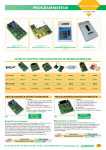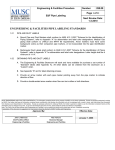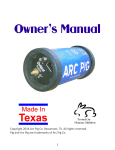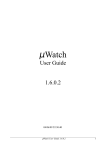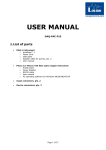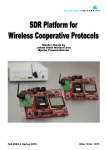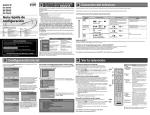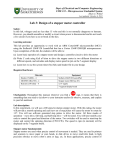Download System Design and Project Plan
Transcript
System Design and Project Plan PEZ (Pills EZ) Dispenser October 12, 2010 Ben Anderson Kyle Smith Matt Strasser Jason Terhune Yao “Annie” Yao PEZ System Design and Project Plan System Design and Project Plan ··· Table of Contents System Design ………………………………………………………….……………… 3 Background ……………………………….………………………………………. 4 System Overview …………………………………………………………………. 4 Block Diagram ………………………………………………………………...….. 5 Functional Description of Blocks ……………………………………………...…. 6 Project Plan ………………………………………………...…………….……………. 9 Organization and Management……………………...……………………….….....10 Work Breakdown Structure (Fall) …………………………...……………..…….11 Work Breakdown Structure (Spring) ………………………..….……….………. 12 Budget ………………………………………………………….…..…….……… 13 Fall Gantt Chart …………….……………………………….…...………………. 14 Spring Gantt Chart …………………………………………………………..…… 15 Fall Network Diagram ………………..………………………………………….. 16 Spring Network Diagram ……………………………………….….…………….. 17 Appendices ………………………………………………...…..……………………… 18 System Requirements Specification ….……………….…………………...…….. 19 2 System Design and Project Plan ··· System Design 3 System Design and Project Plan ··· System Design PEZ (Pills EZ) Dispenser Background Presently, many people are dependent upon medications in their daily lives. An increasing number, especially the elderly, are required to take multiple different types of medications of varying dosages at different times throughout the day. This can become a complicated procedure for anyone, causing missed doses, incorrect doses, and potentially life threatening mistakes. Medication works best when taken on a routine schedule at the proper dosage. Although, medicine dispensing machines that can solve these problems currently exist, they can range upwards of twelve hundred dollars. Clearly, the average household cannot afford this indispensable luxury. Based on this situation, a user friendly, affordable, semi-compact device to dispense medicine at home will be developed. System Overview The PEZ Dispenser prototype will attempt to simplify the medication dosing process for the average customer. The correct dosage of medication will be dispensed throughout the day based on user determined specifications entered via keypad. The user will be prompted to take medications throughout the day by an alarm with an audible range similar to that of an average bedside alarm clock. The interior of the dispenser, which can be accessed upon unlocking the lid, will hold a circular, rotating tray on which will be eleven individual containers. It has been determined through research1 that the average individual takes no more than ten different types of medication. Therefore, up to ten of these containers can be filled by the user with the desired medication. The eleventh container will be used to dispense medication. The correct amount of medication will be obtained through a vacuum system by which individual pills will be lifted from their containers and transported to the dispensing container. The central processing unit, or the microprocessor, will store all information needed to display a clock, sound an alarm, and dispense a dose of medication. The dispenser will be powered by a standard 120V AC, 60Hz power supply. In case of emergency, the dispenser will be equipped with a back-up battery which will provide at least 12 hours of reserve power. 4 System Design and Project Plan ··· Block Diagram 5 System Design and Project Plan ··· Functional Description of Blocks Power Supply The power supply system receives 110 VAC from a wall outlet. It then steps down the voltage and current to the correct magnitude for each of the subsystems. Input: 110 VAC, 60Hz Grounded Output: To microprocessor – 5 VDC at 300 mA To alarm – ±15 VDC at 20 mA To keypad – 12 VDC at 20mA To LCD – 12 VDC at 50mA To pill tray motor – 12 VDC at 600 mA±200 mA To vacuum nozzle control motor – 12 VDC at 600 mA ± 200 mA To vacuum – 110 VAC, 60Hz (direct from wall) Microprocessor The microprocessor will store all information needed to display a clock, sound an alarm, and dispense a dose of medication. The microprocessor will interface with an alpha/numeric keypad, LCD (Liquid Crystal Display), alarm components, vacuum circuitry, and the motor control circuitry. A user will be able enter all information needed via the keypad. The clock display and all prompted information needed from program will be displayed via LCD. The appropriate signals will be sent to control the motors motions. Also, the vacuum control circuitry will be sent a five volt digital signal to activate the vacuum. Input: Power 5V DC at max of 300 mA Digital signals from Keypad 0 to 5V at 0 to 20mA Output: Digital signal to alarm circuitry – 0 to 5V DC at 0 to 25 mA Digital signal to LCD – 0 to 5V DC at 0 to 25 mA Digital signal to keypad – 0 to 5V DC at 0 to 25 mA Digital signal to vacuum – 0 to 5V DC at 0 to 25 mA Digital signal to motor control circuit – 0 to 5V DC at 0 to 25 mA Input/Output System: LCD The user will be able to view any stored data pertaining to the alarms set, medications stored, and dosages entered. The LCD will display the current time along with a number of messages to the user. These messages include things such as, setting a user pin, questions about entering new medication data, prompting visually when medication is ready for removal, and setting the clock. 6 System Design and Project Plan ··· Input: Output: Power 0 to 5V DC at max of 200mA Digital Signals from Microprocessor 0 to 5V DC at 0 to 25mA Text to viewing area. Keypad When prompted, or if the user needs to interact with PEZ, the user will enter information via keypad. The keypad will be alpha/numeric and send all digital signals to the microprocessor for decoding and storage. Input: Output: Power 0 to 5V DC at max of 20mA Digital Signals from Microprocessor 0 to 5V DC at 0 to 25mA Digital signals to microprocessor 0 to 5V at 0 to 20mA Alarm The alarm will sound indicating a dose is scheduled to be taken. The alarm will be audible at a minimum of 80 dB and a tone of approximately 1000 Hz. Input: Power 0 to 12V DC at 50mA Output: > 80 dB Tone Pill Tray/Motor The pill tray will contain the user’s pill prescriptions. It will hold up to ten different pill types, and it will be capable of holding up to 90 1.0 gram pills. A motor having an output torque in the range of 0.15-0.3 N-m will be sufficient to rotate the tray. The motor will rotate the tray through the necessary angle so that the prescribed pill’s bin will be located on the suction nozzle assembly’s axis of translation. Input: 12 VDC at 600 mA±200 mA Output: Correct pill bin is positioned on the nozzle assembly’s axis of translation. Vacuum The vacuum will provide enough suction to lift and hold pills of various masses, ranging from 10 mg to 1.0 g. The necessary force provided by the vacuum, therefore, is equivalent to the force needed to overcome the force of gravity on a 1.0 g pill, 0.00981 N. Input: 110 VAC, 60Hz Output: Suction 7 System Design and Project Plan ··· Nozzle Assembly/Motor The nozzle assembly will translate the suction tip of the vacuum hose into the pill bin directly below it, allowing it to make contact with each pill and affix to it. The nozzle will be selected such that small pills or pieces of pills cannot be sucked inside. The torque requirements for the motor to drive the assembly have yet to be determined. 12 VDC at 600 mA ± 200 mA Output: Vertical translation of the vacuum’s nozzle Input: Frame/Encasement The encasement will provide protection for the components of the dispenser, and the frame will provide sufficient strength to support the system and allow for transportation. The encasement will have a locking door which will allow access to the pill tray in the event that power cannot be supplied. The dimensions will be in the range of 41 cm x 41 cm x 41 cm (16 in x 16 in x 16 in) to 77 cm x 77 cm x 77 cm (30 in x 30 in x 30 in). Input: None Output: None 8 System Design and Project Plan ··· Project Plan 9 System Design and Project Plan ··· Organization and Management Our team consists of two mechanical engineering students, two electrical engineering students, and a computer engineering student. Project management and design tasks will be broken down into the following responsibilities: · Kyle Smith (Electrical Engineer) Kyle is the project manager and responsible for the project being completed on time and under budget. He will ensure the required documents and presentations assigned are completed and turned in on time. He is responsible for design and construction related to the alarm circuit and backup battery system. · Ben Anderson (Mechanical Engineer) Ben will be in charge of the proper selection and modification of the vacuum assembly as well as a backup for Matt on the frame, pill tray, and nozzle assembly. · Matt Strasser (Mechanical Engineer) Matt will be in charge of the design and construction of the frame, pill tray, and nozzle assembly. He will also act as a backup for Ben on the remaining mechanical processes in the project. · Jason Terhune (Computer Engineer) Jason will be responsible for the microprocessor and the user interface for the device, which includes an LCD and a keypad. He will also design and order a PCB to act as a hub for all devices controlled by the microprocessor. · Yao “Annie” Yao (Electrical Engineer) Annie will be responsible for the power supply design and construction as well as being a backup for Jason on the user interface and microprocessor. Each engineer is responsible for the completion of the individual tasks to which they have been assigned, however, it is important to note that work done on each task is not exclusive to the engineers listed. Every member of the team will be expected to be familiar with each other’s systems and to keep their ultimate integration in mind at all times during the design process. 10 System Design and Project Plan ··· Work Breakdown Structure (Fall) ID F 1.0 Task Name Project Selection F 2.0 Preliminary System Design Requirements Specification System Design and Project Plan Report F 3.0 F 4.0 F 4.1 F 4.2 F 5.0 F 5.1 F 5.2 F 5.3 Presentation Mechanical Systems Design Pill Tray Assembly/Motor Vacuum System Deliverables/Checkpoints Project confirmation Duration 8/30-9/7 People All Choose best solutions and apply them 9/7-9/28 All Document that sets the quantitative requirements for the project Breakdown of design and build process and detailed scheduling Write detailed report regarding the above ideas Present the ideas to faculty Detailed design of each mechanical subsystem Holds pills and uses motor to rotate tray Written document 9/10-9/28 All Written document and formal presentation Written document 9/28-10/14 All 9/28-10/12 All PowerPoint and verbal presentation SolidWorks models, analysis, data sheets, calculations, etc. SolidWorks model, analysis, calculations, and motor data sheet Calculations and testing 10/8-10/14 9/28-11/5 SolidWorks model, analysis, calculations, and motor data sheet SolidWorks model and dimension calculations Electrical schematic, analysis, and data sheets Electrical schematic, analysis, and calculations Electrical schematic, analysis, and calculations Power consumption calculations 10/5-10/26 All Ben, Matt Matt, Ben Ben, Matt Matt, Ben Matt, Ben Jason, Kyle Annie, Kyle Kyle, Annie Kyle, Annie Kyle, Annie Retrieves pills from chambers F 9.1 I/O System Design LCD Screen Translates vertically to retrieve pills from chambers Encapsulates all components of the project Microprocessor selection and mounting solutions Provides power from the wall to all subcomponents of the system Provides a 12-hour alternate power supply when wall power is unavailable Estimate power draw from all subcomponents Research best choice for battery chemistry to meet power consumption and size requirements Allows user to input, view pill information, and set alarms Displays vital information to the user(s) F 9.2 Keypad Allows the user(s) to input information F 9.3 Alarm System F 10.0 System Analysis F 11.0 F 11.1 F 11.2 Final Design Report/ Presentation Build Mock-up F 12.0 Documentation F 13.0 Project Management Audibly alerts the user(s) when it is time for a dose Ensure that individual parts will integrate into the system as a whole Final system and sub-function design Write detailed report regarding the above ideas and present ideas to faculty Build a non-functioning physical representation of the system Keep records of all design work, research, and tests Supervise the completion of project goals on time and within budget F 5.4 F 6.0 F 7.0 F 8.0 F 8.1 F 8.2 F 9.0 Vacuum Nozzle Assembly/Motor Frame Design Description Make a final decision on which project to pursue Basic design of what system will do Microprocessor Selection Power Supply Selection Battery Backup System Design Estimate Power Consumption Select Battery Chemistry 11 Analysis, data sheets, and part selection 9/28-10/19 10/1-10/15 10/26-11/5 10/6-10/11 9/28-10/19 10/1210/26 10/1210/26 10/1210/26 Electrical schematic, analysis, and data sheets Electrical schematic, analysis, and data sheets Electrical schematic, analysis, and data sheets Electrical schematic, analysis, and data sheets Finalized system design 10/13-11/8 11/9-12/6 Jason, Annie Jason, Annie Jason, Kyle Kyle, Annie All Written document and presentation Written document and formal presentation Fully-assembled structure representing each sub-system Documents and engineering notebooks Deadlines, constraints, and specifications met 11/15-12/9 11/9-12/9 All All 11/9-12/9 All 8/30-12/9 All 8/30-12/9 Kyle 10/1310/22 10/15-11/8 10/13-11/8 System Design and Project Plan ··· Work Breakdown Structure (Spring) ID S 1.0 S 1.1 S 1.2 S 1.3 S 1.4 S 1.5 Task Name Parts Assembly and Testing Pill Tray and Motor Vacuum System Vacuum Nozzle and Motor Power Supply Description Assemble all parts and verify that they work correctly Build, assemble, and test rotation of the tray Test system using required range of pill types and attach to nozzle assembly Build, assemble, and test vertical translation Implement and test voltage control circuit Backup Battery System I/O System Implementation Build and test that the battery will power system for 12 hours System through which the user interfaces with the prototype S 1.6.1 LCD Screen S 1.6.2 Keypad S 1.6.3 Alarm System S 1.7 S 1.8 User Interface Configuration Board Etching S 2.0 S 3.0 Programming Project Status S 3.1 Report S 3.2 S 4.0 S 6.0 S 7.0 Presentation System Frame Assembly System Integration System Testing Finalize Prototype S 8.0 User’s Manual S 9.0 S 9.1 Final Project Report S 9.2 Presentation Connect and test LCD screen with the microcontroller Create and test a keypad circuit for user input Build and test that alarm sounds at programmed times Configure the keypad and LCD to work with programming Design circuit boards for final system and etch them Write and test code for microcontroller Description of current progress of the project Write detailed report regarding the above ideas Present the ideas to the faculty Build frame to house all subcomponents Compile all modules to create prototype Run full system test Verify correct operation and prepare for presentation Describes how to use the device and any special considerations Final design and functioning prototype Write detailed report regarding the above ideas Present project to faculty S 10.0 Documentation S 11.0 Project Management S 1.6 S 5.0 Keep records of all design work, research, and tests Supervise the completion of project goals on time and within budget 12 Deliverables/Checkpoints Working modules and test data Duration 1/20-4/25 People All Functioning system of tray and motor assembly Functioning vacuum pill-retrieval system Functioning system of vacuum nozzle, gear, and rack Working module that steps down the voltage and current to the correct values Functioning battery system 1/20-2/1 Matt, Ben Ben, Matt Ben, Matt Annie, Kyle All components built and functioning to specifications 2/10-3/11 Working LCD screen that outputs all text correctly at the appropriate time Working keypad that can be used to input information Functioning, fully-audible alarm 2/22-3/11 Working user interface 2/22-3/11 Professional and self-made circuit boards Functioning system code Report and presentation 4/11-4/25 1/20-3/11 2/15-3/10 Kyle, Annie Jason, Kyle, Annie Jason, Annie Jason, Kyle Kyle, Annie Jason, Annie Kyle, Annie Jason All Written report 2/15-3/8 All PowerPoint and verbal presentation Completed frame 3/8-3/10 3/22-4/8 Assembled project and test data 3/22-4/11 All Matt, Ben All Test data Completed prototype 4/11-4/25 4/25-5/3 All All Document 4/12-4/30 All Report and presentation Written report 4/5-5/5 4/5-5/3 All All PowerPoint, verbal presentation, and demonstration Documents and engineering notebooks Deadlines, constraints, and specifications met 5/3-5/5 All 1/18-5/5 All 1/18-5/5 Kyle 2/1-2/15 2/15-3/1 1/20-2/1 2/1-2/8 2/22-3/8 2/10-2/18 System Design and Project Plan ··· Budget Item Motor (to rotate tray) Tray Motor (for nozzle assembly) Gear and Rack Vacuum Plexiglas (4’ x 8’) tools/building materials (for frame and enclosure) Microprocessor (PIC30F) LCD Keypad Battery Power Supply Alarm PCB (manufactured and self-made) Estimated Costs Prospective Vender Cost ($) www.robotshop.com www.rexart.com www.robotshop.com 38.00 2.00 20.00 Estimate Date 0ct.4,2010 0ct.4,2010 0ct.4,2010 www.qtcgears.com www.virtual-ii.com www.professionalplastics.com Lowe’s 100.00 90.00 150.00 75.00 0ct.4,2010 0ct.4,2010 0ct.4,2010 0ct.4,2010 www.microchipdirect.com 10.00 0ct.4,2010 www.robotshop.com www.jameco.com www.all-battery.com www.Amazon/spytown.com www.Amazon.com www.PCBexpress.com 17.95 21.95 35.00 30.00 10.00 75.00 0ct.4,2010 0ct.4,2010 0ct.4,2010 0ct.4,2010 0ct.4,2010 0ct.4,2010 Total 674.90 Contingency 325.10 Budget 1,000.00 13 Fall Gantt Chart 14 Spring Gantt Chart 15 Fall Network Diagram 16 Spring Network Diagram 17 System Design and Project Plan ··· Appendices 18 System Design and Project Plan ··· REQUIREMENTS SPECIFICATION Background Our team will analyze, build and test an automatic pill dispenser. This dispenser will be powered by a 120V AC, 60Hz power supply with a back-up battery to provide at least 12 hours of reserve power. The user will easily interface with the dispenser; in return it will dispense the correct amount of pills, on time, with the prompt of an alarm clock. The automatic pill dispenser combines microcontrollers with mechanical technologies, allowing for one user. The machine will operate with precision (explained further in test plan), ensuring that the correct prescription is dispensed at every instance of operation. System Overview According to the data released by PRIME Institute for Families USA, annual spending per elderly person for prescription drugs grew from $559 in 1992 to $1,205 in 2000, an increase of 116 percent. By 2010, annual per person spending on drugs for the elderly is projected to reach $2,810 a year, an increase of 133 percent over spending in 2000 (http://answers.google.com/answers/threadview/id/563761.html). This data indicates that an everincreasing number of elderly people are going to join the community of “medicine dependent people”, and significantly greater quantities of prescription medicine will be given to people daily. As a result, not only for the elderly people, but also for this group of people who are heavily dependent on medication, taking pills correctly and punctually will be a growing problem. There is a product designed to dispense medicine that has already been on the market; however, it costs $1,200. Based on this situation, our group will research and develop an easily-manipulated device to dispense medicine at home, and reduce the manufacturing cost of the dispenser as much as possible. Operational Description (Draft User’s Manual) Important Safeguards: 1. All users of the PEZ must read and understand this owner’s manual before operating the PEZ. 2. The power cord should be plugged into a 120V AC electrical outlet only. 3. If the PEZ begins to malfunction during use, immediately unplug the cord. Do not use or attempt to repair the malfunctioning PEZ. Contact Team PEZ for further instructions. Introduction: To-Do: insert a brief description of the PEZ. 19 System Design and Project Plan ··· Before you use the PEZ for the first time: 1. Use inventory provided on first page of this manual to confirm all parts are present. 2. Assemble the PEZ and make sure the on/off switch is set to off. 3. Plug in the PEZ to power. Set the clock: 1. Turn power switch to on position. 2. Details for this will be included once more research is done about the microprocessor. Manual Entry of prescriptions or vitamins: 1. A step by step procedure will walk the user thought a process of adding medication and alarms. Cleaning and Maintenance: A build up residue may hinder the performance of the pill counting mechanism. For best results, completely clean and dry all removable parts monthly or when needed. When cleaning your PEZ, please observe the following precautions: 1. Make sure the PEZ is off and unplugged. All user data and dosage information will not be lost. 2. NEVER IMMERSE THE CORD, PLUG OR PEZ IN WATER OR OTHER LIQUID. 3. Do not use metal cleaning pads or abrasive cleaners. Requirements 1. Will handle up to 10 different kinds of pills ranging from 10 milligrams to 1 gram. 2. No more than four kinds will have the same mass, no more than four will have the same coating, and no more than three will have the same shape. 3. The alarm to take the dosage will sound within two seconds of the programmed time. 4. Should take no more than one minute to transport one pill from its holding chamber to the dispensing chamber. 5. Will alert the user when it is time to take a dose of medicine. 6. Prescription information (how many of each kind of pill to be taken at a specific time of day on certain days) can be entered manually through a user interface using a keypad and screen. 7. Will alert the user when a pill supply gets low (three days dosage left). 8. Will allow the user to access the pills by entering a secret PIN code. This applies when loading a supply of pills or retrieving a dose of pills. 9. Will be powered by a standard 120 V, 60 Hz, AC outlet. 10. Will have a battery back-up lasting at least 12 hours. 11. Should be a table-top device that can be carried by a typical person (definition of a typical person further explained in the test plan). 20 System Design and Project Plan ··· Design Deliverables 1. 2. 3. 4. 5. 6. 7. 8. User Interfacing Alarm Notifying Medication Times User Recognition Of Size Such that the Average Person can Lift it User’s Manual List of Parts and Their Prices Schematics Automated Pill Dispenser Compatible with 1 user Preliminary Test Plan To test the pill dispensing functionality of the device, we will perform the following test (spanning 12 hours each run) three times: · · · · · · · · Plug Device into the wall for necessary power Load the hopper with 10 different types of Pills A user PIN will be assigned and then the pills can be placed in the machine. Different dosing schedules including: once a day, twice a day, and three times a day, including one or two pill doses using the LCD/Keypad interface will be tested. An alarm will sound alerting the user that it is time to pick up a prescription and the PIN will be entered. Once the PIN is entered, no less than one pill per minute (checked via stopwatch) will be dispensed until the dose has been completely dispensed. If there is only three days worth of a pill remaining, the user will be alerted by an alarm and an on screen message immediately following the dose retrieval that causes the amount to fall below the three day threshold. The system time will be checked against a digital clock/watch and will lose a maximum of two seconds during the test. To test the backup battery system, the above test will be run twice running only on battery power for 12 hours with the following modifications: · Pills and Dose Schedules will already be present in the machine To test that the device can be carried by a typical person, the following test will be performed: · Five people will be chosen at random and asked to carry the device from one end of a room to the other. 21





















